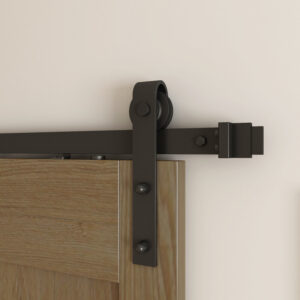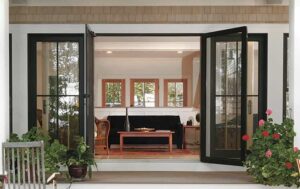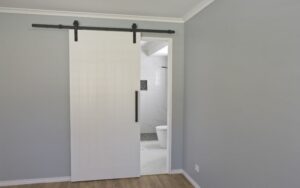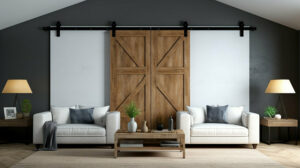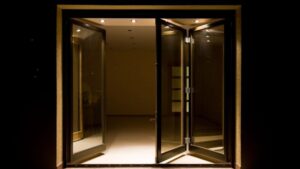When you start decorating your house and selecting the windows and doors, you may consider which is the right type. Swing doors and sliding doors are two types of patio doors.
Swing doors, the traditional door style, are hinged and offer a classic look that complements many architectural styles. They’re versatile and can be found in most homes, often providing a sturdier feel and the option for a wider opening, which can make moving large items in and out a breeze.
On the flip side, sliding doors are the type of door that is go-to for saving space and a modern look designed to slide horizontally and not swing open. If you’re tight on room, or if you’re aiming for a sleek, contemporary vibe, sliding doors can slide right into your plans. They’re also great for areas that lead to outdoor spaces like patios or decks because they provide an unobstructed view and don’t swing out to take up precious outdoor living space.
Each option has pros and cons for ventilation, aesthetics, and usage, and your choice hinges on what your specific needs are. You might prioritize energy efficiency, ease of access, or security. Understanding the differences will help you make a decision that fits your home’s style and function.
Design Considerations and Aesthetics
When you’re picking between swing doors and sliding doors, the design, materials, and how they fit with your home’s style are just as crucial as their function. You’ll want to consider not just how these doors look, but also how they’ll shape your living spaces.
Style and Material Choices
Your choice between a swing door and a sliding door can significantly influence the aesthetic appeal of your room. Swing doors often offer a classic look and can come in a variety of materials including wood and glass. On the other hand, sliding doors tend to present a more modern and stylish façade, especially when they feature large panes of glass that provide a seamless outdoor view.
- Wooden Doors: Rich textures and warm colors for a traditional look.
- Glass Doors: Sleek and allow natural light, enhancing modern interiors.
Impact on Living Spaces
The door type you select can alter the perception of space within your home. Swing doors require clearance to open, which may reduce the effective area of smaller rooms. In contrast, sliding doors glide parallel to the wall, maximizing the usable space and often making the room appear larger.
- Swing doors: Require space for the door arc.
- Sliding doors: Ideal for limited space, offering a space-saving solution.
Customization Options
Both swing and sliding doors come with various customization options. You can choose from a spectrum of colors and finishes that complement your home’s interior design. Sliding doors have the unique advantage of being able to feature tinted or frosted glass for added privacy without sacrificing style.
- Colors: Match or contrast with your room’s palette.
- Finishes: Matte, glossy, or satin to align with your style.
- Glass Customizations: Tinted, frosted, or clear to suit your privacy needs.
Functional Differences
When choosing between swing and sliding doors, you’ve got to consider how they’ll fit into your daily life.
Accessibility and Convenience
Swing doors can be more user-friendly; they’re typically easier to open and close. However, in areas where you often have your hands full, a sliding door can be a nifty way to get through without the hassle, just a simple slide to the side and you’re through.
Ventilation and Natural Light
Both door styles can light up your room with natural light, but sliding doors usually offer better ventilation options. Simply slide ’em open, and you’ve got a decent amount of air coming in—plus, screens keep out the unwanted bugs and debris.
Installation, Maintenance, and Durability
When choosing between sliding and swing doors, you’ve got to consider more than just looks. Let’s get into how they stack up in terms of getting them in, keeping them up, and how long they’re gonna hold up.
Installation Requirements
Sliding Doors: You’re gonna need a clear section of wall for the tracks to sit flush against. Proper installation means ensuring those tracks are level; otherwise, you might find your door tends to jam. Rails have to be secured and aligned for smooth operation.
Swing Doors: They rely on hinges. Make sure you’ve got a solid frame because that’s where your door’s gonna hang from. The hinged doors need to be sturdy to endure abrupt closing and the weight of the door, especially if it’s a heavier material.
Maintenance Needs
Sliding Doors: They need love with their tracks and rollers. Dirt and grit can cause problems, so you’ll want to keep them clean to prevent jamming. A bit of lubricant on the tracks can go a long way to maintain ease of movement.
Swing Doors: Simpler in design, they’re often easier to maintain. Regular checks on the hinges will prevent sagging doors and reliability issues. No tracks mean one less thing to clean, but watch for any wear or squeaking from your hinges.
Long-Term Durability
Sliding Doors: Modern sliding doors have shoved aside the rep for being fragile. With sturdy glass and reliable frames, they can hang with the best. Still, tracks can wear out, and misalignment can creep in over time.
Swing Doors: These bad boys are often seen as more durable because they have fewer moving parts to worry about. As long as you’ve got those hinges working like they should and your door isn’t prone to being slammed, it’ll likely stand the test of time.
Don’t forget that sound insulation can tip the scales, too. Swinging doors have an edge for sealing off noise due to their design fitting snugly into door frames.
Comparing Safety and Energy Efficiency

When choosing between swing and sliding doors, it’s crucial to consider both the security and energy efficiency features they offer. You’ll find that each type has its own set of benefits that could sway your decision based on your specific needs.
Security Measures
Swing Doors:
- Locks: Typically, swing doors offer a variety of lock options, from standard deadbolts to multi-point locking systems, enhancing your home security.
- Frame and Lower Rail: The structure tends to be robust, with a sturdy frame and lower rail that resist forced entry better than some sliding door designs.
Sliding Doors:
- Single-action Locking: These doors often have a single-action lock, which may be less secure than the locks on swing doors, but additional security bars or foot locks can enhance protection.
- Screens and Privacy: Sliding doors usually come with screens, which can provide an extra layer of security and the bonus of added privacy. In comparison, many French doors and other hinged patio doors are designed without integrated screens.
Insulation and Energy Savings
Swing Doors:
- Weatherstripping: Swing doors can be equipped with weatherstripping, including magnetic seals similar to those on a refrigerator door, which are excellent for retaining heat.
- Insulation: They often have a lower U-factor, indicating better insulation and heat retention, making them more energy-efficient in colder climates.
Sliding Doors:
- Glass-to-Frame Ratio: Sliding doors have larger glass areas, potentially leading to more heat loss, but modern options include double-glazing and energy-efficient frames to help conserve energy.
- Disabilities Access: They provide an advantage for energy efficiency in homes with disability requirements, as their design requires less space and effort to operate, eliminating the need for extra insulation or security features that might hinder accessibility.
Remember, the right door for you hinges on balancing your security needs with your energy conservation goals.
In summary, there is no definitive “best” option between swing and sliding patio doors. The optimal choice depends on your priorities and needs related to space, views, ease of access, security, functionality, and visual appeal.
For those with compact patio spaces wanting to maximize natural light and seamless indoor-outdoor views, sliding patio doors tend to be the preferred style. Their narrower frames accommodate larger glass panels.
However, they do not open fully and may present some security concerns. Homeowners wanting a more traditional look, wider access points, and enhanced security may favor swinging patio doors. Their ability to open fully enables smoother traffic flow. Swing patio doors also enable sturdier multi-point locking systems. However, they do require a wider footprint and swing radius to operate.

